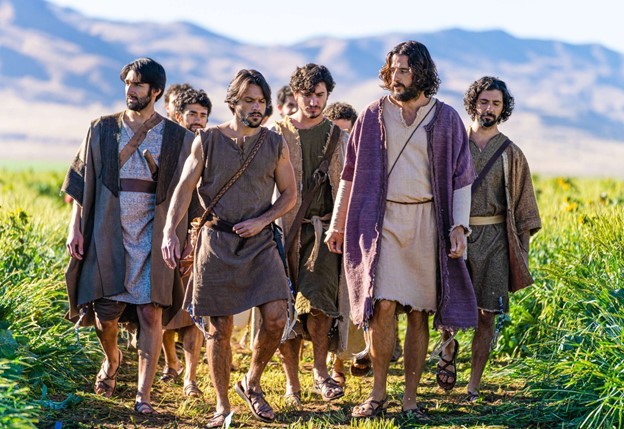
It's rare to be able to describe a TV series as "unique," but The Chosen fits the bill. Take, as a first example, the "look" of the TV series/app. There's a warm feeling when viewing the show; light - be it daylight or candlelight - hits the actors' faces in a way that's never harsh nor dim. This is thanks to some innovative combinations of tech. Cinematographer Akis Konstantakopoulos, GSC, used two ARRI ALEXA Mini cameras, which he eventually equipped with lenses from Cooke Optics Ltd., a company founded in 1893. Looking for the perfect lens that provided a "vintage" feel with all the modern trimmings, Konstantakopoulos settled on Cooke's Panchro/i Classics lenses, a modern redesign of lenses popular as far back as the 1920s. The upgraded models allow for frame-by-frame digital information capture. He told Digital Media World TV that the effect was, "... a look that is very close to what the human eye sees, but feeling cinematic and unique. I was also dealing with a lot of varying skin tones and was confident that I could rely on the Cooke lenses to render all of them faithfully and beautifully."
Those with an interest in cinematography, movies, or TV are mostly in agreement that the creators of this "Christian app" TV series did a good job re-creating the time period, with sets in Texas and later Utah standing in for the Judea of Christ's day. Likewise with the costumes; which is among the more difficult challenges for any period drama. The only critique might be the actors' perfect teeth; dentistry 2,000 years ago was poor, to say the least, and the perfect teeth are perhaps the only thing that takes you "out" of the otherwise near-perfectly-created ancient world. The "varying skin tones" referred to above are a triumph. We are treated to a wide array of peoples and hues, from a lighter-skinned Roman soldier (perhaps from some part of more northern Europe) to black characters - who are not primarily slaves. Logically, a multi-ethnic Israel then-ruled by the Roman Empire would have had Africans and mixed-race residents - some of whom were probably Jewish.
In 1977, Franco Zeffirelli gave the world the epic four-part Jesus of Nazareth and created an enduring image of Jesus: that of UK actor Robert Powell... a white man with piercing blue eyes. Deliberately, Powell did not blink during his scenes and wore blue eyeliner to enhance his truly beautiful eyes. The only problem? The historical Jesus was born in Judea and it's close to unfathomable that he was a blue-eyed white man. Instead, the real Jesus likely looked a lot more like The Chosen's cast pick for Christ - Jonathan Roumie, a brown-eyed, brown-haired, not particularly tall man who - in costume - looks racially vague enough to pass as Semitic - he's certainly not a northern European. The same is true for the rest of the cast, who also look like they fit into the times.

Getting the show from idea to reality took more than a pinch of "faith." The creators pitched a crowdfunding idea that boiled down to, "buy shares in the production, and if and when there is money made, we promise you'll get profits before the director - Dallas Jenkins - and his production team does." But the leap worked and tens of thousands signed up to finance season one, using something called "equity crowdfunding," a highly regulated provision of the JOBS Act, which became law in mid-2016. With strict oversight from the U.S. Securities and Exchange Commission (SEC), production companies - and other entities - are allowed to offer a share of profits to online strangers who wish to back a project. When the first fundraising round wrapped up in January 2019, The Chosen had raised over US$10.2 million from over 16,000 investors, becoming the world's top crowdfunded film project. By July 2020, over US$6 million had come in from over 300,000 investors to finance the making of season two, which premiered on Easter Sunday, 2021. The series is viewed via a free app - as well as on YouTube. Seven seasons are planned and the producers and distributor, Angel Studios, say they hope the series will be viewed by more than one billion people across the planet. TV channels have also begun broadcasting season one, and it's so far garnered - over all platforms - over 60 million views globally.
Texas was the site for season one, but a small, largely uninhabited town created as a set for the ancient city of Jerusalem in Goshen, Utah became the principal site for season two. This Jerusalem set was built by the Church of Jesus Christ of Latter-day Saints - LDS, or Mormons - for their church productions but, for the first time, the LDS allowed an outside group to use this as-near-as-possible accurate re-creation of the ancient holy city.
Blend the tech used by director Jenkins and crew, the faith and earnestness - without being 'preachy' - of the cast, and The Chosen depicts a very different story of the life of Christ than has been previously seen. The disciples and others are "real" people, who talk and act - not like saints or stereotypes - but like fishermen, or a tax collector, or a wife. Likewise for the character of Jesus. He is almost the perfect opposite of the Robert Powell version: this Jesus makes jokes, laughs, plays with kids, dances at a wedding, and has more than one "serene" facial expression - in short, this is Jesus as a human. The show - predictably a smash hit with believers - is also catching the eyes of some secular viewers, who are enjoying a fresh take on this very old story. The challenge now for The Chosen is keeping its - so far - stellar writing, acting, and cinematography going strong for seven seasons.
* This is a contributed article and this content does not necessarily represent the views of techtimes.com








